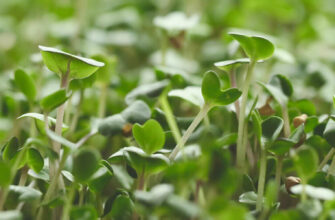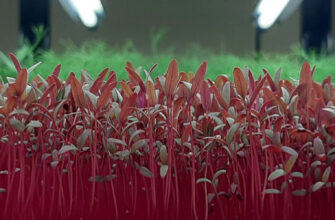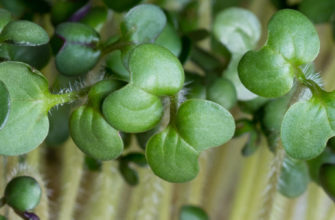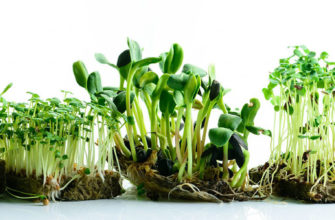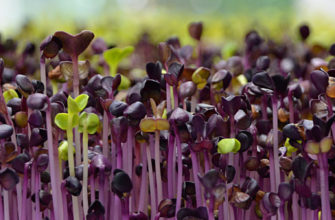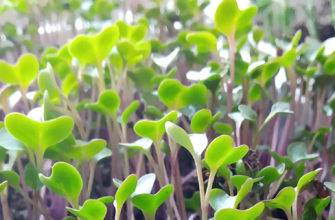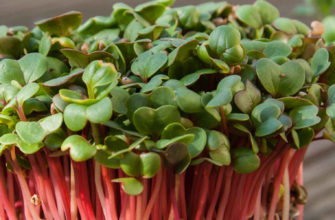Sprouts are young plants with cotyledon leaves, grown by soaking, draining, and regularly rinsing seeds over 3–5 days. They are extremely beneficial for human health and add a unique twist to everyday dishes.
Due to their high nutritional value, sprouts are popular among vegetarians, raw food enthusiasts, and those who follow healthy diets. Read on to learn how to sprout seeds for consumption, their health benefits, and ways to prepare them.
- Health Benefits of Sprouts
- Which Seeds Can Be Sprouted?
- Basic Methods of Sprouting Seeds for Food
- Sprouting in a Jar
- Sprouting on a Plate
- Sprouting Seeds for Food in a Sprouter
- Sprouts in Cooking
- Recipes with Sprouted Seeds and Grains
- Green Buckwheat Sprout Smoothie
- Korean-Style Sprouted Soybeans
- Korean-Style Sprouted Mung Bean Salad
- Recipe for Bread with Sprouted Wheat Grain
- Preparation:
- Nuts from Sprouted Chickpeas
- Sauce Recipe from Sprouted Lentils
Health Benefits of Sprouts

Sprouting increases the nutritional value of plants and improves digestion. Young sprouts contain 10 to 100 times more glucoraphanin, an enzyme that protects the body against cancer-causing agents.
They are rich in antioxidants and increase chlorophyll activity, which helps detoxify the body by raising oxygen levels.
Sprouting also boosts mineral and vitamin content, including vitamin D. Here are some health benefits that will convince you to start sprouting seeds:
- Improved Digestion. Sprouts are rich in fiber and live enzymes that speed up metabolic processes and chemical reactions in the body. Enzymes help efficiently break down food and improve nutrient absorption.
- Supports Healthy Circulation. Sprouts help maintain healthy red blood cell levels as they contain iron and copper. They also improve oxygen delivery to organs and cells, optimizing their function. Good blood circulation stimulates hair growth.
- Aid in Weight Loss. Sprouted seeds are ideal for weight management. They are nutrient-dense but low in calories, allowing you to eat sprouts without worrying about weight gain. High fiber content keeps you full longer and suppresses ghrelin, the hunger hormone.
- Immune System Boost. Rich in vitamin C, sprouts stimulate white blood cells to fight infections and viruses, strengthening immunity.
- Improves Vision. Vitamin A in sprouts supports eye health. They also contain antioxidants that protect eyes from free radicals.
- Reduces Acidity. Sprouts help regulate body pH by lowering acidity, which is linked to many diseases, including cancer.
- Prevents Premature Aging. Eating sprouted seeds protects DNA from damage and fights free radicals that cause cell damage and aging.
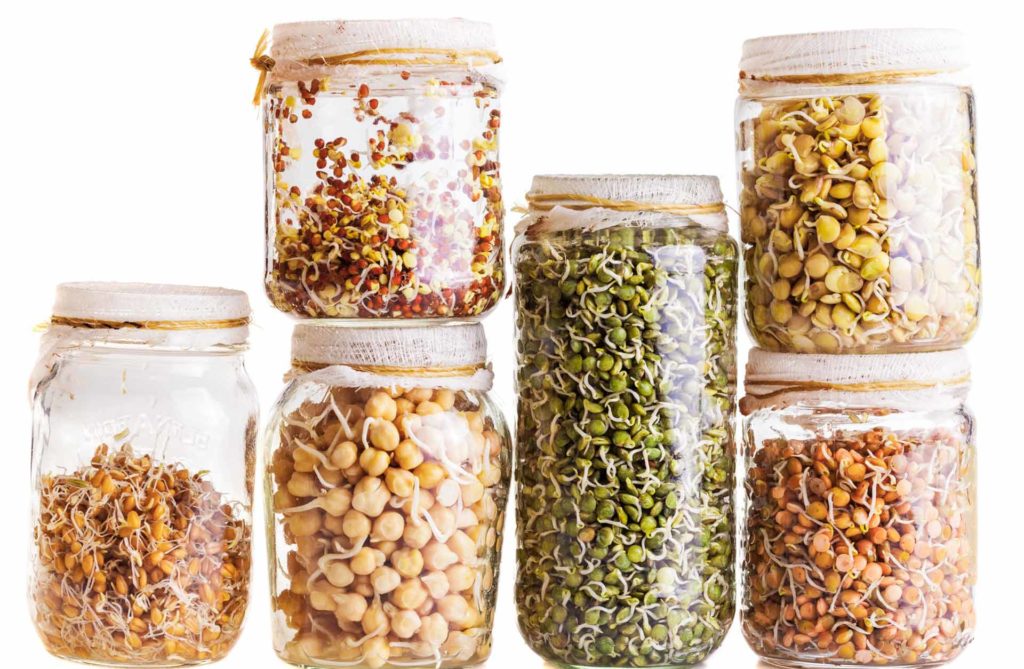
Which Seeds Can Be Sprouted?
All viable seeds can be sprouted, but some sprouts are unsafe to eat raw. Here are commonly consumed sprouts:
- Legumes: alfalfa, clover, fenugreek, lentils, peas, chickpeas, mung beans, soybeans
- Grains: oats, wheat, corn, rice, barley, rye
- Pseudocereals: quinoa, amaranth, buckwheat
- Oilseeds: sesame, sunflower, almonds, hazelnuts, hemp, flaxseed, peanuts
- Cruciferous: broccoli, cabbage, cress, mustard, mizuna, radish, daikon, arugula, turnip
- Umbellifers: carrot, celery, fennel, parsley (often grown as microgreens but also suitable for sprouting)
- Alliums: bulb onion, leek, green onion
- Other vegetables and herbs: spinach, salad greens, milk thistle, lemon grass
Avoid sprouting and eating raw seeds from:
- Nightshade family (tomatoes, potatoes, peppers, eggplants)
- Buckwheat family (rhubarb) — as they may be toxic raw.
Choose pesticide-free, organic seeds for sprouting.
Basic Methods of Sprouting Seeds for Food
Seeds require moisture, warmth, and light (indirect) to sprout. Photosynthesis begins only when leaves appear; before that, light has little effect.
Sprouting in a Jar
Materials:
- Untreated seeds
- Glass jar (0.5–1 L)
- Cheesecloth and rubber band or a mesh lid
Instructions:
- Rinse the seeds thoroughly for one minute and place them in a glass jar with water.
- Make sure the water is twice as much as the seeds because the seeds will absorb part of the water during sprouting.
- Remove and discard any floating grains or debris to avoid losses.
- Cover the jar’s mouth with cheesecloth or a special lid with a fine mesh and secure it tightly.
- Place the container indoors at room temperature for 3 to 12 hours, depending on the type of seed.
- Drain the water through the cheesecloth, pour in fresh water, and shake to rinse the sprouts thoroughly.
- Place the jar at a 45° angle so that excess moisture drains and does not cause mold on the seeds. This way, optimal humidity for sprouting will always be maintained in the jar.
- Repeat this process twice a day until the seeds sprout (this may take about 4 to 5 days). If the room is hot, increase the number of rinses up to 5 times per day.
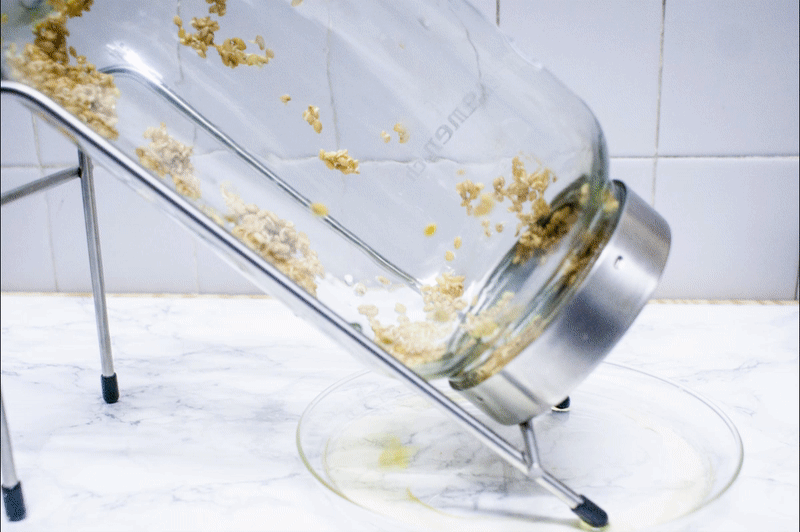
Sprouting on a Plate
You can use various containers for this, including plastic containers, small trays, clay pots, cake lids, etc. Only metal containers are not suitable for sprouting seeds for food.
Materials:
- Untreated seeds
- Shallow plate
- Cheesecloth
Instructions:
- Soak seeds as for jar sprouting.
- Spread seeds thinly on a plate, cover with cheesecloth.
- Rinse twice daily using a sieve or spray with water, avoid excess moisture to prevent mold.
- Also, instead of rinsing, you can spray the seeds with a spray bottle, but make sure that too much moisture does not accumulate on them, as this can cause mold to develop.
Sprouting Seeds for Food in a Sprouter
A sprouter is a wide jar with a tray and a lid. Most often, a sprouter has several levels for simultaneously sprouting different types of seeds. Water is poured into the tray, and thanks to this, the sprouter always maintains optimal moisture and temperature for the young sprouts.
Sprouters made of clay, glass, as well as automatic sprouters, are available for purchase. However, it is worth noting that the sprouting time for all three of these methods does not differ; the difference is only in convenience.
What you need to take:
- seeds;
- sprouter.
How to sprout seeds for food in a sprouter:
- Soak and rinse the seeds as in the previous methods.
- Pour the seeds into trays with holes and cover them with the lid.
- Water the trays 1-2 times a day. The water will drain into the trays below, but the seeds will remain moist.
Sprouts in Cooking
Sprouts are very versatile. They can be fried, boiled, pickled, or eaten fresh. Generally, green sprouts (such as alfalfa, clover, broccoli, onion, and radish) are suitable wherever salads are served.
All green sprouts are quite interchangeable but have different flavors. Sprouted seeds are added not only to salads but also to rolls, smoothies, pasta, sandwiches, sushi, and as a side dish for meat or fish.
They make excellent decoration for grilled dishes and are added when serving soups, stews, and eggs. Try mixing crushed mung bean or radish sprouts with soft cheese, and you will get a spicy spread for toasts or fresh bread.
You won’t believe it, but you can even make healthy cheese and bread from sprouts! Overall, sprouted seeds can be used practically everywhere in cooking.
Recipes with Sprouted Seeds and Grains
Green Buckwheat Sprout Smoothie
Because sprouted green buckwheat loses its unique taste and benefits after heat treatment, it is recommended to consume it fresh. We suggest preparing a vitamin-rich smoothie to support immunity, which is especially important during the winter season.
Ingredients:
- Green buckwheat sprouts – 70 g
- Banana – 1 piece
- Kiwi – 1 piece
- Pear – 1 piece
- Grapefruit juice – 150 ml
- Honey – 1 tablespoon
Preparation:
Peel the fruits, rinse the sprouts, and put all the ingredients into a blender. Blend until smooth and drink the smoothie fresh.
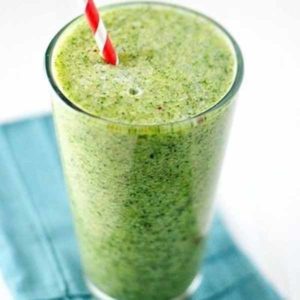
Korean-Style Sprouted Soybeans
СоSoybeans are a wonderful source of protein, fatty acids, and vitamins. This sprouted soybean salad is not only healthy but also very tasty.
Ingredients:
- Sprouted soybeans – 450 g
- Onion – 1 piece
- Garlic – 2 cloves
- Red sweet pepper – 0.5 piece
- Oil – 7 tablespoons
- Soy sauce – 2 teaspoons
- Black ground pepper and salt – to taste
Preparation:
Boil the sprouts in boiling water for 3–4 minutes, then drain them thoroughly using a colander. Finely chop the onion and sauté it in oil until soft. In a large bowl, combine the sprouted soybeans, onion, finely chopped pepper, minced garlic, and soy sauce.
Then season the salad with pepper and salt, keeping in mind that the salad should be spicy. Mix everything well and place it in the refrigerator for 30 minutes.
Enjoy your meal!
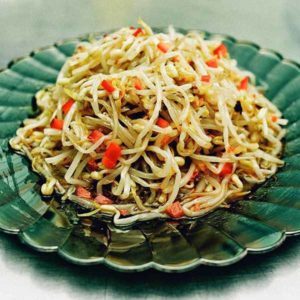
Korean-Style Sprouted Mung Bean Salad
Recipes with sprouted mung beans and other legumes are very popular in Asian cuisine. It’s no surprise since sprouts are very healthy and, being sprouted, cook much faster compared to whole beans. Here is a recipe for Korean-style sprouted mung bean salad made with easily accessible ingredients.
Ingredients for the salad:
- Sprouted mung beans – 1 cup
- Onion – 1 piece
- Green onion – 50 g
- Cucumber – 1 piece
- Apple – 1 piece
- Sunflower oil – 2 tablespoons
- Olive oil – 2 tablespoons
- Cardamom, black ground pepper, and salt – to taste
Preparation:
Peel the apple and grate it on a coarse grater. Finely chop both kinds of onions. Cut the cucumber into cubes. Sauté the onion until golden and place it in a large bowl. Add the green onion, apple, cucumber, sprouted mung beans, olive oil, spices, and mix everything well.
Let the salad rest for 15–30 minutes before serving. It will be ready to enjoy!
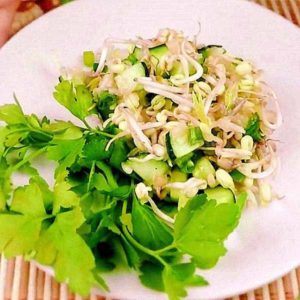
Recipe for Bread with Sprouted Wheat Grain
This bread recipe using sprouted wheat is quite simple and even beginners can handle it. It’s important to note the health benefits of this bread since it uses a sourdough starter instead of yeast.
Bread made from sprouted wheat grain is easier to digest and promotes better gastrointestinal function. Take care of your health and try baking it with us!
Ingredients for the sourdough starter:
- Flour – 160 g
- Water – 200 ml
Ingredients for the dough:
- Water – 60 ml
- Sourdough starter – 2 tbsp
- Sprouted wheat grain – 8 tbsp
- Vegetable oil – 1 tbsp
- Salt – 0.3 tsp
- Sugar – 1 tsp
Preparation:
The sourdough starter needs to be prepared in advance. To do this, mix water and flour in a bowl, cover with a towel, and place in a warm place for 2–3 days (depending on the temperature). Meanwhile, sprout the wheat until white tails appear.
When the sourdough starter and sprouts are ready, you can start preparing the dough. First, grind the sprouts in a blender or through a meat grinder. In a large bowl, mix all the ingredients well and cover with a napkin. Leave the dough to rest for 7–8 hours (for example, overnight). During this time, it will rise and increase by 1.5–2 times.
After that, grease the baking pan with oil and very carefully transfer the dough into it. The bread made from sprouted grain will bake in the oven for 1 hour at a temperature up to 180°C.
If you want to make the bread again, do not throw away the sourdough starter, but put it in the refrigerator in a tightly closed jar. This way, it can be stored for up to two weeks.
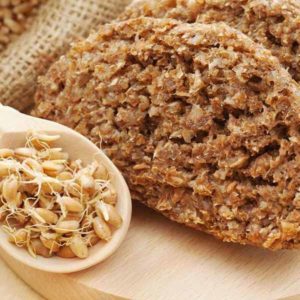
Nuts from Sprouted Chickpeas
Sprouted chickpeas are an excellent alternative to unhealthy chips and similar snacks. They contain only natural ingredients with minimal heat treatment. These “nuts” can be eaten as a standalone dish or added to vegetable salads. We suggest making nuts from sprouted chickpeas with this simple recipe.
Ingredients:
- Sprouted chickpeas – 300 g
- Curry – 1 tsp
- Sweet paprika – 2 tbsp
- Sesame oil – 2 tbsp
- Dried rosemary – 1 tsp
- Dried basil – 1 tsp
- Oregano – 1 tsp
- Thyme – 1 tsp
- Cayenne pepper – 1/2 tsp
- Salt – 1 tsp
Preparation:
Marinate the sprouted chickpeas in spices and oil for 10 minutes up to 12 hours. Line a baking tray with parchment paper and spread the chickpeas in a single layer. Put the tray with chickpeas into a preheated oven at 180°C for 15 minutes.
At the end, you can lightly salt the “nuts” and enjoy them while watching your favorite movie.

Sauce Recipe from Sprouted Lentils
Sprouted lentils pair perfectly with vegetable salads and appetizers. A sauce made from sprouted lentils is ideal for fresh vegetables, lavash chips, crispbreads, or can be an excellent dressing for vermicelli.
Ingredients:
- Green lentils – 100 g
- Water – 250 ml
- Juice of half a lemon
- Cilantro – a small bunch
- Salt, spices – to taste
- Olive oil – optional
Preparation:
Combine sprouted lentils, cilantro, lemon juice, and spices in a blender bowl. Blend everything until smooth.
Enjoy your meal!
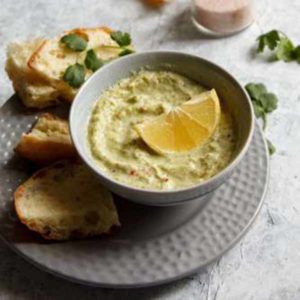
Now you understand sprouting, are ready to order microgreen seeds, and start working! If you have any questions, feel free to leave them in the comments below.
Wishing you successful sprouting!
If you have found a spelling error, please, notify us by selecting that text and pressing Ctrl+Enter.

